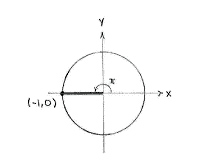Solution 4.2:3c
From Förberedande kurs i matematik 1
m (Lösning 4.2:3c moved to Solution 4.2:3c: Robot: moved page) |
|||
| Line 1: | Line 1: | ||
| - | {{ | + | |
| - | < | + | We can add and subtract multiples of |
| - | {{ | + | <math>\text{2}\pi </math> |
| + | to or from the argument of the sine function without changing its value. The angle | ||
| + | <math>\text{2}\pi </math> | ||
| + | corresponds to a whole turn in a unit circle and the sine function returns to the same value every time the angle changes by a complete revolution. | ||
| + | |||
| + | For example, if we can subtract sufficiently many | ||
| + | <math>\text{2}\pi </math> | ||
| + | s from | ||
| + | <math>\text{9}\pi </math>, we will obtain a more manageable argument which lies between | ||
| + | <math>0</math> | ||
| + | and | ||
| + | <math>\text{2}\pi </math>, | ||
| + | |||
| + | |||
| + | <math>\text{sin 9}\pi =\text{sin}\left( 9\pi -2\pi -2\pi -2\pi -2\pi \right)=\sin \pi </math> | ||
| + | |||
| + | |||
| + | The line which makes an angle | ||
| + | <math>\pi </math> | ||
| + | with the positive part of the | ||
| + | <math>x</math> | ||
| + | -axis is the negative part of the | ||
| + | <math>x</math> | ||
| + | -axis | ||
| + | and it cuts the unit circle at the point | ||
| + | <math>\left( -1 \right.,\left. 0 \right)</math>, which is why we can see from the | ||
| + | <math>y</math> | ||
| + | -coordinate that | ||
| + | <math>\text{sin 9}\pi =\text{sin }\pi =0</math>. | ||
| + | |||
| + | |||
| + | |||
[[Image:4_2_3_c.gif|center]] | [[Image:4_2_3_c.gif|center]] | ||
Revision as of 11:57, 28 September 2008
We can add and subtract multiples of \displaystyle \text{2}\pi to or from the argument of the sine function without changing its value. The angle \displaystyle \text{2}\pi corresponds to a whole turn in a unit circle and the sine function returns to the same value every time the angle changes by a complete revolution.
For example, if we can subtract sufficiently many \displaystyle \text{2}\pi s from \displaystyle \text{9}\pi , we will obtain a more manageable argument which lies between \displaystyle 0 and \displaystyle \text{2}\pi ,
\displaystyle \text{sin 9}\pi =\text{sin}\left( 9\pi -2\pi -2\pi -2\pi -2\pi \right)=\sin \pi
The line which makes an angle
\displaystyle \pi
with the positive part of the
\displaystyle x
-axis is the negative part of the
\displaystyle x
-axis
and it cuts the unit circle at the point
\displaystyle \left( -1 \right.,\left. 0 \right), which is why we can see from the
\displaystyle y
-coordinate that
\displaystyle \text{sin 9}\pi =\text{sin }\pi =0.

